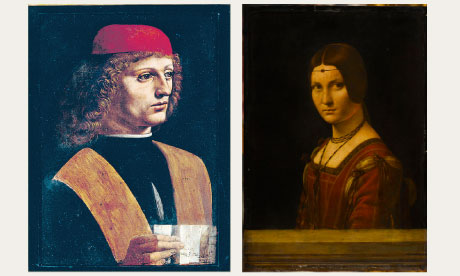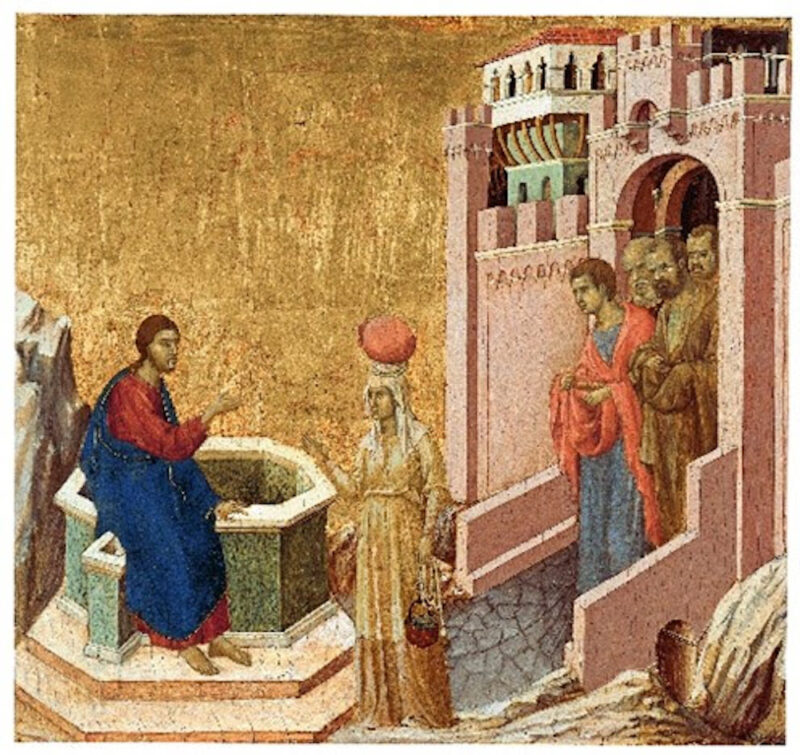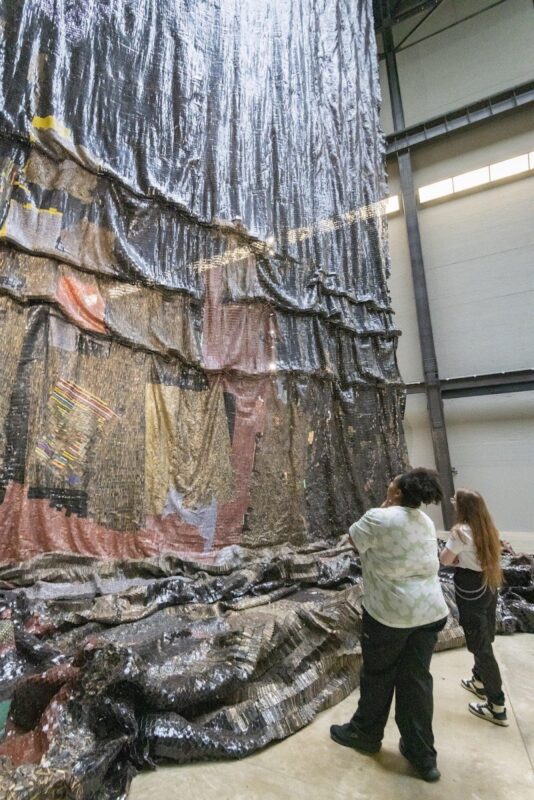
The Musician (left ) and La Belle Ferronnière, by Leonardo da Vinci. Photograph: Milano/De Agostini Picture Library; Musee du Louvre, Paris/Veneranda Biblioteca Ambrosiana
Renaissance man though he undoubtedly was, Leonardo da Vinci was very much a part-time artist. Among the wrecks and ruins and dubious attributions, Leonardo produced very few paintings – around 20, about some of which scholarly debate continues. There are nine in the National Gallery exhibition, all dated from his years in Milan, as well as Giampietrino’s almost 8 metre-wide 1520 scale copy of Leonardo’s 1492-8 Last Supper.
What Leonardo paintings are left are in varying states of incompletion, over-restoration and decay. Varnish has browned and grown opaque, paint layers have been scrubbed away, colour (particularly the lapis lazuli blue) has gone out of whack, and restorers and improvers as well as time have done their work.
About a third of the way into the National Gallery’s thoughtful, vital Leonardo show is an engraving of a circular pattern at whose empty centre lie the words Leonardi Academia. Perhaps the engraving is the seal of an academy in Milan, where humanists, poets, artists and musicians, supported by the Duke of Milan, Ludovico Sforza, Leonardo’s patron, gathered. Or maybe it is an emblem of Leonardo’s workshop.
No one knows if he made the engraving himself, but Leonardo undoubtedly drew the design. The engraving is an endlessly turning and criss-crossing knot, a sort of visual knitting whose repeated swirls and flourishes recall Islamic patterns, well known from imports to Italy in the 1400s. The wall label would like us to regard this gorgeous pattern as a precursor of abstract art. It bursts before us and sucks us in. It is a visual labyrinth, an optical game. The severity of the engraving and the pleasure of the pattern are as one.
The more scholarly art-historical pleasures of deciding what this engraving means and why it was made are just a footnote to the many mysteries and conundrums surrounding Leonardo’s life and work.
Some mysteries are more compelling than others, and some things we can never know for sure. What, for example, is the music Leonardo’s Musician, also known as Portrait of a Young Man, is reading? Has he just stopped singing or is he about to begin? What moment is this, and who is he, shown in three-quarter profile, one hand lightly holding the unfolded sheet of music, his face serious but not severe, the pupil of one eye larger than the other?
The picture captures a transitional moment, not just for the man in the picture but for the painting itself, which for all its detail appears partly unfinished – most conspicuously the man’s broad lapels are a frankly brushed single layer of brownish underpaint. We are caught between completion and finish. The end of the song, perhaps, but not of the painting. Leonardo himself wrote that “painting lords it over music because it does not perish as soon as it is created, as unfortunate music does.”
The painting and the viewer are left hovering. All these factors come into play as we stand and look, and become part of the experience of looking itself, caught between one thing and another, one moment and the next. The same thing happens in the room where Leonardo’s two versions of the Virgin of the Rocks face one another for the first time in their long histories. The first, a 1485 altarpiece (from the Louvre), is gloomy with yellowed varnish and sunken colour. The second version, to which Leonardo returned throughout the 1490s and again in 1506-8, is from the National Gallery’s collection.
I keep turning between them to make comparisons, seeing the same gaping views between the rocks, then larger and smaller differences everywhere I look. In the end, as well as the cleaner and more vibrant colour, it is the gaping sculpted void under the Virgin’s cloak in the second version that drags me in. In fact, it is the architecture of space that really makes both these paintings, and I find myself looking over and around the figures in both versions.
Everywhere else one looks, there are drawings, both by Leonardo and his assistants and followers, a constant commentary on form. Slow metal-point drawings, faster pen-and-ink and chalk drawings, a sea of drawings on which Leonardo’s few paintings, and those of his contemporaries and followers, float like so much flotsam.
But it’s the portraits that really hold me. In room after room we encounter paintings by Leonardo that refuse to be pinned down. What keeps them alive is what keeps them escaping from us.
The Lady with an Ermine, Leonardo’s 1489-90 portrait of Cecilia Gallerani, who became Sforza’s mistress at the age of 15 , turns away from us, alert to something beyond the painting, a slight smile about to break on her lips, never mind that overgrown weasel (a play on her name and a talisman of pregnancy and childbirth, purity and moderation) she cradles in her arms [see footnote]. Painted a few years later, the Belle Ferronnière, also known as Portrait of an Unknown Woman, also appears to be thinking about something external – like Cecilia, her focus seems to be on someone approaching, or perhaps departing. She looks suspicious, or troubled, or passing from one state of mind to another. Leonardo seems to be recording her unknowable mental activity, her inner absorption, and in regarding her, we project our modern mores.
This portrait does seem in itself modern. Her presence is palpable. The catalogue describes how her position and cropping make her look like a bust, the parapet or low wall in front of her acts like a plinth. This combination of the static and the mobile (the latter being all about expression, and the way the light falls) is extremely clever. As is the little jewel on her forehead, held on a cord around her head. It pins her in place even as she turns.
For a long time it was assumed that Leonardo had painted a Saviour of the World, or Salvator Mundi, but that the painting was lost, and all that survived were later engravings and dubious copies, including the newly restored head of Christ here. New research published this summer has now identified this as an authentic Leonardo. Or at least some of it. Maybe. What a difficult painting this is to like, let alone to be affected by. Jesus has the glazed look of someone stoned. You can imagine the raised fingers holding a spliff. Once imagined, the image won’t go away. In the same way that it is hard to forget the moustache Marcel Duchamp supplied the Mona Lisa with, making her a cartoonish drag king (and amplifying the idea that the Mona Lisa is a sort of transvestite self-portrait of the artist), I can no longer see the Salvator Mundi on its own terms. It is difficult enough, in any case.
Much about the painting’s inner mystery has been acquired along the way. Christ’s head, built up with layer upon layer of thin glazes, has lost many of its layers. Instead of nuance, what we have instead is that strange slightly out-of-focus look, and a sense that Christ’s presence is somehow hovering just beyond reach. How much of this apparition-like look is deliberate is hard – perhaps impossible – to tell.
Leonardo may well have wanted to suppress any sign of brushwork, and to give the impression that the image is a miraculous rather than painted image of Christ. What is amazing is the rendering of the transparent rock crystal sphere Christ holds in his left hand, and the way that the painting leads you in through different degrees of representation, the whole thing becoming more unworldly the deeper one looks. The painting gave him the opportunity to think about description itself, however disconcerting the image now appears.
Leonardo da Vinci saw things and recorded what he saw. He wrote more than he drew, and he drew incessantly. An observer as much as an inventor, he covered full pages and scraps and torn sheaves with his notes and the things he had seen with his mind’s eye. Drawings punctuate, annotate, interrupt and surprise us at every turn, and are the first and last things we see in this exhibition.
The first is a sheet depicting a cross section through a man’s profiled head, and shows us hair breaking like little waves over the layers of skin covering the skull. The cross-section shows the sinus behind the eyebrow, and the passage from the eyeball leading into the ventricles of the brain, ventricles that were Leonardo’s supposition rather than a record of what he had seen. It is like a vestige of the medieval mind.
The final exhibit we see is upstairs in the Sunley Room, where a full-sized copy of the Last Supper is hung. It is an open notebook, small enough to fit in a pocket (though assembled as a volume some time after Leonardo’s death). On the page, Leonardo describes a dinner. “One who has been drinking and has left the glass in its place and turned his head towards the speaker… Another with his hands spread open shows the palms, and shrugs his shoulders up to his ears, making a mouth of astonishment… Another blows his mouthful…Another leans forward to see the speaker…” he writes. On it goes, the unnamed participants turning and gesticulating and reacting to one another and to something said.
The supper he describes might well be drawn from observing the men around him as he ate, thinking about the Last Supper, which he had barely begun painting on the wall of Santa Maria delle Grazie in Milan in the early 1490s.
The popular imagination casts Leonardo as part Gandalf, part Einstein, a maker of miracles and something more than mere genius. Leonardo breeds obsession in academics and amateurs alike. It is hard to look at him in measured terms. In fact, it is hard to look at him in the way that we look at the works of other artists.
You hover between interpretation and visual presence: the deliberate and the damaged, the sacred and the stoned. And between the paintings that punctuate and look at one another, echo and mirror and converse with one another, Leonardo’s invaluable litter of sketches, studies, meanderings, jokes and notes remind you that these were the products of an enquiring, lively, mortal mind. It was a mind that teemed – so many diverse things crowd the single papers and notebook pages, with passages of writing, a new method for fixing lead to a roof, a ball-race for a rotating pedestal.
He would also sometimes begin a drawing close to the empty paper’s edge, leaving himself no space for its completion. It is as if he was for ever projecting his thoughts and observations into the world, and sometimes missed the screen, in his hurry and enthusiasm, or would overlay multiple images until they became an almost unidentifiable black smudge. Or he would counter one image with its opposite, a finely delineated profile with a cartoonish grotesque.
It is in his drawings that Leonardo truly comes alive for me, and that’s where his spirit is. This exhibition is undoubtedly a unique event. We are never likely to see so many of Leonardo’s paintings bought together in our lifetimes. But however scrupulous and scientific, research takes us only so far. Time has done its work on Leonardo’s art. The rest is history and speculation, and the pleasures of looking.
• This footnote was appended on 18 November 2011. The ermine is a stoat (Mustela erminea), not a common weasel (Mustela nivalis). It is, however, also known as a short-tailed weasel.
guardian.co.uk © Guardian News & Media Limited 2010
Published via the Guardian News Feed plugin for WordPress.









